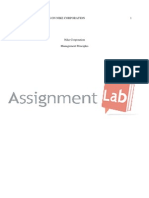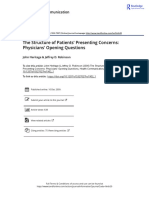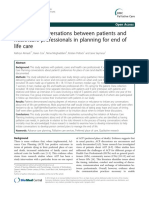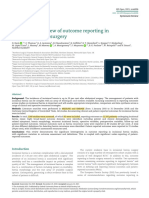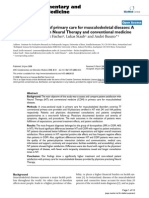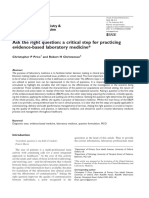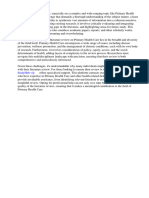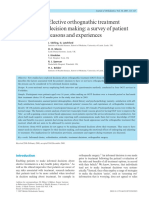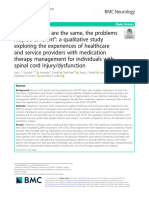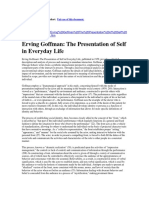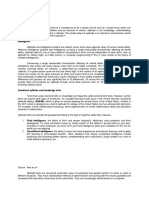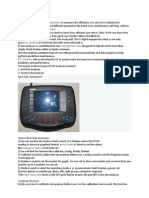0 ratings0% found this document useful (0 votes)
389 viewsAnamnesis 2014
Anamnesis 2014
Uploaded by
Daniel Araya RochaThe document discusses opening clinical encounters between physiotherapists and patients. It observed initial and follow-up encounters between physiotherapists and patients with back pain to identify preferred questions for opening encounters. A survey of physiotherapists found the preferred question for initial encounters was asking the patient to describe the problem, and for follow-ups was asking how the patient has been since the last visit.
Copyright:
© All Rights Reserved
Available Formats
Download as PDF, TXT or read online from Scribd
Anamnesis 2014
Anamnesis 2014
Uploaded by
Daniel Araya Rocha0 ratings0% found this document useful (0 votes)
389 views5 pagesThe document discusses opening clinical encounters between physiotherapists and patients. It observed initial and follow-up encounters between physiotherapists and patients with back pain to identify preferred questions for opening encounters. A survey of physiotherapists found the preferred question for initial encounters was asking the patient to describe the problem, and for follow-ups was asking how the patient has been since the last visit.
Original Description:
anamnesis 2014 paper sobre anamnesis
Original Title
anamnesis 2014
Copyright
© © All Rights Reserved
Available Formats
PDF, TXT or read online from Scribd
Share this document
Did you find this document useful?
Is this content inappropriate?
The document discusses opening clinical encounters between physiotherapists and patients. It observed initial and follow-up encounters between physiotherapists and patients with back pain to identify preferred questions for opening encounters. A survey of physiotherapists found the preferred question for initial encounters was asking the patient to describe the problem, and for follow-ups was asking how the patient has been since the last visit.
Copyright:
© All Rights Reserved
Available Formats
Download as PDF, TXT or read online from Scribd
Download as pdf or txt
0 ratings0% found this document useful (0 votes)
389 views5 pagesAnamnesis 2014
Anamnesis 2014
Uploaded by
Daniel Araya RochaThe document discusses opening clinical encounters between physiotherapists and patients. It observed initial and follow-up encounters between physiotherapists and patients with back pain to identify preferred questions for opening encounters. A survey of physiotherapists found the preferred question for initial encounters was asking the patient to describe the problem, and for follow-ups was asking how the patient has been since the last visit.
Copyright:
© All Rights Reserved
Available Formats
Download as PDF, TXT or read online from Scribd
Download as pdf or txt
You are on page 1of 5
Original article
Opening clinical encounters in an adult musculoskeletal setting
Emily C. Chester
a
, Natalie C. Robinson
a
, Lisa C. Roberts
a, b,
*
a
Faculty of Health Sciences, Building 45, University of Southampton, Higheld, Southampton, Hampshire, SO17 1BJ, United Kingdom
b
Therapy Services Department, University Hospital Southampton NHS Foundation Trust, Tremona Road, Southampton, Hampshire,
SO16 6YD, United Kingdom
a r t i c l e i n f o
Article history:
Received 15 December 2013
Received in revised form
24 March 2014
Accepted 27 March 2014
Keywords:
Communication
Interaction
History-taking
Musculoskeletal
Physiotherapy
a b s t r a c t
Effective communication between healthcare professionals and their patients is crucial for successful
consultations, and can profoundly affect patients adherence to treatment. Despite this evidence,
communication within the physiotherapy profession is still underexplored, in particular, how best to
open clinical encounters. This study explores the issue by seeking the preferences of physiotherapists for
opening encounters in the adult musculoskeletal outpatient setting. Initially, 42 consultations and 17 rst
follow-up encounters were observed between qualied physiotherapists and patients with back pain.
These encounters were audio-recorded, analysed and used to develop a questionnaire to determine
clinicians preferences for opening encounters. From these ndings, a synopsis of the questionnaire was
posted on the four most-relevant professional networks of the national, interactive Chartered Society of
Physiotherapy (iCSP) website, to canvass opinion more widely. Among the 43 physiotherapists who
responded, the preferred key clinical question for an initial encounter was: Do you want to just tell me a
little bit about [your problem presentation] rst of all?; and for follow-up encounters: How have you been
since I last saw you? These results provide an important and novel contribution to the profession, as
debate on this issue has not previously been published. Although the sample size in this study is small,
the aim of this paper is to generate reection and debate among clinicians on their preferences for
opening patient encounters and optimising the non-specic treatment effects.
2014 The Authors. Published by Elsevier Ltd. This is an open access article under the CC BY license
(http://creativecommons.org/licenses/by/3.0/).
1. Introduction
Effective communication between healthcare professionals and
patients is crucial for a successful clinical encounter (Gask and
Usherwood, 2002) and impacts upon every patient contact. A
procient medical interview is fundamental to creating a good
interpersonal relationship, as well as information exchange and
optimal professional decision-making (Ong et al., 1995; Stewart,
1995). Furthermore, in developing patient-centred care, clini-
cians are advised to attend not only to the disease, but to the
patients experience of symptoms, the impact of the condition and
what really matters for the patient (Pollock, 2001; Walseth et al.,
2011).
It is imperative that healthcare professionals consider their
communication skills right from the outset, as it is reported to take
only 39 ms for a rst impression to be made (Bar et al., 2006) and
many encounters to change (Tongue, 2007). The early stages of the
clinical encounter are also when patients present their problems to
the clinician. Heritage and Robinson (2006) introduced the term
problem presentation to describe the stage at which patients
disclose information about their symptoms to the clinician. This
important component is reported to be the only time in a medical
encounter that patients are given the opportunity to describe their
condition in their own words and address their own personal
agenda (Heritage and Robinson, 2006).
When patients are given the opportunity to participate, they are
more likely to work alongside the healthcare professional and have
increased satisfaction with the outcome (Glueckauf, 1993; Payton
et al., 1998), with both parties sharing knowledge and power
(Edwards et al., 2004). However, research has also highlighted that
clinicians communication, and in particular, how they phrase their
questions about the problem presentation, can affect patient
satisfaction (Heritage and Robinson, 2006; Robinson and Heritage,
2006) as well as adherence to treatment (Zolnierek and Dimatteo,
2009). Therefore, the clinicians communication skills are vital in
establishing a good interpersonal relationship with patients,
creating a welcoming environment, and enabling patients to freely
express their issues.
* Corresponding author. Faculty of Health Sciences, Building 45, University of
Southampton, Higheld, Southampton, Hampshire, SO17 1BJ, United Kingdom.
Tel.: 44 (0)23 8059 5311.
E-mail address: L.C.Roberts@soton.ac.uk (L.C. Roberts).
Contents lists available at ScienceDirect
Manual Therapy
j ournal homepage: www. el sevi er. com/ mat h
http://dx.doi.org/10.1016/j.math.2014.03.011
1356-689X/ 2014 The Authors. Published by Elsevier Ltd. This is an open access article under the CC BY license (http://creativecommons.org/licenses/by/3.0/).
Manual Therapy 19 (2014) 306e310
To date, research into howclinicians should open their clinical
encounters is at an early stage of development and predominantly
focuses on physicians working in primary care settings (Heritage
and Robinson, 2006; Robinson and Heritage, 2006). These studies
explored opening encounters using video-recorded data; however
it has been reported that a camera can alter the natural ow of
communication between clinicians and patients (Roberts and
Bucksey, 2007). Furthermore, it is unknown how well the nd-
ings from medical encounters translate to clinical encounters
involving other healthcare professions.
Within physiotherapy, communication studies have tended to
focus on, interactions and relationships, the content of encounters
and the impact upon outcome (Roberts et al., 2013), with none
specically addressing the issue of opening clinical encounters.
Therefore, this study aims to address the gap using a series of
audio-recorded consultations from an outpatient setting, to iden-
tify the phrasing preferred by physiotherapists when opening
clinical encounters in an adult musculoskeletal outpatient setting.
2. Method
2.1. Stage 1: observational study
2.1.1. Study design
The rst stage was a cross-sectional, observational study of in-
teractions between musculoskeletal physiotherapists and patients
with low back pain.
2.1.2. Setting
This study took place in a primary care service in Southern
England. Patients were referred to the service by their General
Practitioner (GP), and were allocated an initial 45-min appointment
with a physiotherapist, and further 30-min treatment sessions, as
necessary.
2.1.3. Participants
Patients: The patient sample (n 42) comprised adults aged 18
years, referred with a diagnosis of low back pain (of unspecied
duration), dened as pain in an area bounded by the 12th thoracic
vertebra and ribs superiorly, gluteal folds inferiorly and contours of
the trunk laterally. Patients with a history of recurrent back pain
were included, provided they had received no physiotherapy/
acupuncture within the preceding three months, in order to iden-
tify this episode of back pain as distinct.
The exclusion criteria were: signs and symptoms suggesting
possible serious spinal pathology (red ags); spinal surgery for this
episode; another musculoskeletal disorder more troublesome than
the back pain; consultations (for this episode) with other health
care professionals (excluding the GP); a known severe psychiatric
or psychological disorder; and people who were unable to
communicate in English without assistance.
Clinicians: All physiotherapists working in the study setting
(n 15), registered with the Health and Care Professions Council
and currently managing patients with back pain, were invited to
take part.
2.1.4. Data collection
A small, digital Edirol audio-recorder (model R-09HR, Roland
Corporation, Japan) was placed in the treatment cubicle. The senior
researcher (LR) discreetly sat out of the direct eld of vision of
either participant and took no active part in the consultation,
recording eld notes to contextualise the events that took place
during the encounter. The audio-recordings were transcribed
verbatim and thematically analysed using a Framework approach
(Ritchie et al., 2003).
2.1.5. Findings from stage 1
From the 42 initial physiotherapy consultations, 11 key clinical
questions were identied, which are summarised in Table 1 (col-
umn 3). From the 17 rst follow-up encounters, 7 key clinical
questions were identied, summarised in Table 2 (column 3). The
wording of these questions was then used as the base for a national
survey to determine clinicians preferences.
2.2. Stage 2: survey
2.2.1. Study design
A cross-sectional survey was carried out within the United
Kingdom to identify how physiotherapists prefer to open their
clinical encounters.
2.2.2. Questionnaire
At the inception of the study, no appropriate measuring tool
existed for determining preferences for opening clinical encoun-
ters. Therefore, a bespoke questionnaire was designed based on
audio-recorded clinical encounters from stage one. The 42 initial
consultations were thematically coded and the exact wording of
the key clinical question (KCQ) was identied, i.e. the rst question
where the physiotherapist asks the patient about their presenting
problem, in this case, back pain. Topics discussed prior to this point
(in the opening phase of the consultation) were also identied and
collated. The exact phrasings of the KCQ were used in the ques-
tionnaire to optimise face and content validity.
The questionnaire was established electronically using Ques-
tionMark Perception software and consisted of ten demographic
and eight core questions, charting the initial consultation (four
questions) and follow-up clinical encounter (four questions).
For the initial consultation, participants were asked to identify
and rank their top ve preferred phrasings for the KCQ out of the
eleven options fromstage one. They were also given an opportunity
to identify any alternative phrasing of the KCQ they believed to be
more effective or preferred from their own clinical practice. A
similar format of questions was used for follow-up clinical
encounters.
Prior to the main study, pilot work was conducted using a
convenient sample of seven MSc physiotherapy students and ve
senior physiotherapists, to evaluate the questionnaires accept-
ability and give participants the opportunity to comment on the
layout, design and content of the questionnaire. Minor formatting
changes were made to the questionnaire following this feedback.
Table 1
Results from the national survey showing the preferred phrasing of the key clinical
question in initial consultations between physiotherapists and patients with low
back pain.
Preferences Score Phrase
1st 83 Do you want to just tell me a little bit about [problem
presentation] rst of all?
2nd 77 Ive had this referral through. Tell me whats happened.
3rd 71 The referral says youve got [problem presentation] is
this correct?
4th 65 How can I help you today?
5th 57 What well do today is just have a bit of a chat about
[problem presentation], I believe it is. All right?
6th 45 Its your [problem presentation e.g. knee, back etc.] that
youre here for is it?
7th 35 What problem are you having at the moment?
8th 30 Do you want to tell me your story?
9th 29 Do you want to start off by telling me whereabouts
youre getting your pain at the moment?
10th 28 I know a little bit from the GP, when did this start?
11th 17 How long have you had [problem presentation] for?
E.C. Chester et al. / Manual Therapy 19 (2014) 306e310 307
2.2.3. Data collection
Participants were recruited using the national, interactive
Chartered Society of Physiotherapy website (iCSP). A synopsis of the
study was included in the networks fortnightly email bulletins of
the four most relevant professional networks: i) Sports Medicine;
ii) Orthopaedics; iii) Massage and Soft Tissue Therapy and; iv) Pain
Management. At the time of recruitment, membership of the four
networks totalled 34,922 (including possible duplicates). Members
who were interested in the study were asked to contact the authors
via email and were then sent a link to the electronic questionnaire
and a participant information sheet. The sample included all
available members of the four networks. In addition, the senior
researcher (LR) publicised the study to delegates in a keynote
address at the Physiotherapy Research Society (Shefeld, 2012).
Data were collected between August and October 2012, and were
coded for anonymity. One follow-up reminder was sent.
2.2.4. Data analysis
Descriptive statistics were used to determine physiotherapists
preferred phrasing when opening clinical encounters.
Frequencies were reported for the topics clinicians discussed
before or after their KCQ in both initial and follow-up clinical en-
counters, and a scoring systemwas used to determine the preferred
phrasing. Each rst choice phrase received a score of ve; second
choice received a score of four etc.; down to the fth choice, which
received a score of one. These scores were then summed for each
phrase, to identify the most popular.
Data were managed using SPSS for Microsoft Windows, Release
20.0 (IBM: SPSS Inc) and Microsoft Excel 2010.
Ethical approval was granted from the Faculty of Health Sci-
ences, University of Southampton.
3. Results of national survey
3.1. Demographics
A total of forty-three participants responded, however three
questionnaires were incomplete. The sample included qualied
physiotherapists (n 31) and students (n 12), of whom 18 (42%)
were male and 25 (58%) female. The number of years experience in
musculoskeletal physiotherapy ranged from 2 months to 29 years
(mean: 10 years 10 months, median: 10 years 2 months) and the
number of years qualied ranged from 1 year 3 monthse37 years
(mean: 13 years 10 months, median: 12 years 2 months).
3.1.1. Initial clinical encounter
3.1.1.1. Pre-key clinical question topics. The majority of respondents
reported including the following topics in their clinical encounter
before raising the KCQ: i) a general greeting (n 39); ii) an intro-
duction of their name (n 38) and role (n 31); iii) an explanation
of what would be involved in the consultation (n 31);
iv) conrmation of referrer details (n 28); and v) a check of the
patients personal details (n 32), and preferred name (n 33).
Additionally, 16% (n 7) reported mentioning parking and di-
rections, and 30% (n 13) the weather.
3.1.1.2. Key clinical question. The preferred phrasing of the KCQ in
an initial clinical encounter was Do you want to just tell me a little
bit about (your problem presentation) rst of all? (score: 83).
Preferences for the KCQs are summarised in Table 1.
When clinicians were asked for their own preference for
opening a clinical encounter (i.e. not from the audio-recordings), a
shared theme that arose was to explicitly ask about the patients
presenting problems and why they had come to physiotherapy in
their own words.
The themes participants identied as missing from the ques-
tionnaire included: a check to see if patients had seen a physio-
therapist before; establishing whether patients understood why
they had been referred; and their understanding of the role of
physiotherapy.
3.1.2. Follow-up clinical encounter
3.1.2.1. Pre-key clinical question topics. In the follow-up consulta-
tions, clinicians reported greeting the patient (n 38), giving a
summary of the previous clinical encounters ndings (n 20), and
explaining what would be involved in the follow-up consultation
(n 20) prior to asking them about their problem presentation.
Additionally, 14% (n 6) of respondents reported mentioning
parking, 5% (n 2) directions and 37% (n 16) weather, before the
KCQ. An additional topic respondents deemed important to bring
up was to check how the patient felt after their initial physio-
therapy session.
3.1.2.2. Key clinical question. The preferred phrasing of the KCQ by
physiotherapists in a follow-up clinical encounter was How have
you been since I last saw you? (score: 158). Preferences of KCQs in
the follow-up encounters are summarised in Table 2. When asked if
they had any other preferred ways of opening the encounters, a
theme emerged of asking directly about the patients symptoms.
3.1.3. Audio-recorded consultation/clinical encounters
From the 42 audio-recorded initial consultations, 19% (n 8) of
the KCQs were open, 17% (n 7) were open-focused and 64%
(n 27) were closed. Open questions elicited on average a 22.6 s (s)
(range 1e49 s) response from the patient about their presenting
problem, whilst open-focused and closed questions elicited on
average 47.1 s (range 8e69 s) and 15.4 s (range 1e90 s) responses,
respectively. When answering the KCQ, patients were interrupted
by the physiotherapist in 25 out of 42 consultations (60%), whereas
in the other 17 consultations (40%), patients answers came to a
natural stop before the physiotherapist spoke. Out of these 25
interrupted consultations, responses to closed questions (n 16)
were interrupted sooner (mean 19.9 s) than open (n 4)
(mean 24.8 s) and open-focused questions (n 5)
(mean 45.2 s).
4. Discussion
This exploratory study aimed to identify the preferred phrasing
of physiotherapists when opening clinical encounters in musculo-
skeletal outpatient settings. The results indicate that clinicians are
in favour of using open questions when asking patients about their
problem presentation in both initial and follow-up clinical
Table 2
Results from the national survey showing the preferred phrasing of the key clinical
question in a follow-up clinical encounter between physiotherapists and patients
with low back pain.
Preferences Score Phrase
1st 158 How have you been since I last saw you?
2nd 131 How did you get on with the [treatment e.g. exercises,
hydro, injection, massage]?
3rd 82 How have you been feeling from a [problem
presentation e.g. knee, back etc.] point of view?
4th 71 How are you getting on?
5th 54 How have you been?
6th 18 Are the [problem presentation e.g. knee, back etc.]
symptoms on-going?
7th 12 What was the take home message that you got from me
last time?
E.C. Chester et al. / Manual Therapy 19 (2014) 306e310 308
encounters. Open questions give patients the opportunity to ex-
press their own ideas and experiences freely, whereas closed
questions only look for a yes, no or simple fact response (Evans
et al., 2008). These results relate to previous research, which has
highlighted that when practitioners use open questions at the start
of their consultations, patients report greater satisfaction and
adherence to treatment, as they feel the practitioner has listened to
them, which facilitates the therapeutic relationship (Robinson and
Heritage, 2006; Zolnierek and Dimatteo, 2009).
In the present study, physiotherapists favoured the question:
Do you just want to tell me a little bit about [your problem presen-
tation] rst of all? which is a problem-focused symptom query, and
is both a question and an invitation. In lay terms, this could be
described as an open-focused question, as it allows the patient to
direct the problem aspect. The just . tell me component is elic-
iting a narrative and the clinician is not presupposing a specic
angle or problem, or displaying prior knowledge of the patients
problem, thereby occupying a less knowledgeable (Ke) epistemic
status (Heritage, 2012). It is evident that the question is phrased as
a yes/no interrogative and displays an entitlement contingency,
however it still gives the patient an entitlement to decline. Finally,
the temporal component rst of all sets up that there is more to
come and the patient will therefore have further opportunities to
tell their story. This style of question was favoured over:
narrative open questions (Do you want to tell me your story);
questions that focus on a single, specic issue (Do you want to
start off by telling me whereabouts youre getting your pain at the
moment?);
closed questions (The referral says youve got [problem presen-
tation] is this correct?)
The ndings of the current study are comparable to that of
Marvel et al. (1999), who observed that in 34 out of 264 interviews
between physicians and patients, physicians followed open ques-
tions with open-focused questions when addressing patients
agendas. They commented that this is a useful style to adopt as it
avoids gathering an extensive list of patient concerns rigidly at the
opening of the interview (Marvel et al., 1999). Therefore, asking a
question that allows the patient to express their problem in their
own words, but gives them a focus, may deter the patient from
deviating from the topic and also help to achieve two of the most
important communication skills in a therapeutic setting: the ability
to truly hear what the patient is trying to say; and the ability to
allow the patient to speak without interruption (Jackson, 2006).
Interestingly, in the current study, subsequent analysis of the 42
audio-recorded initial consultations demonstrated that physio-
therapists were inclined to interrupt the patient when answering
the KCQin 60% of cases. Marvel et al. (1999) also found that 45.5% of
patients were interrupted while giving their statement of con-
cerns and this was associated with fewer concerns mentioned by
patients, late-arising concerns, and missed opportunities to gather
important patient data. On average, patients were given 23.1 s to
itemise their concerns before interruption from the physician
(Marvel et al., 1999), although the study did not address the type of
questions that were used prior to the patients response and
whether these questions may have inuenced the response time.
Analysis of the audio-recorded encounters in the current study
revealed that physiotherapists allowed patients to speak for the
longest without interruption following open-focused questions.
This could be because physiotherapists were gleaning useful in-
formation, and patients felt comfortable to express their concerns
in their own words.
Clinicians are encouraged not to interrupt patients opening
statements because determining reasons for the patient pursuing
professional help is important to a successful clinical encounter
(Beckman and Frankel, 1984) and it is reported there is an increased
fondness towards the clinician as the patient discloses this health
information (Collins and Miller, 1994). Patients will typically take
92 s to explain their problem presentation in an outpatient setting
if not interrupted (Langewitz et al., 2002) and will present with an
all-round summary of their problems (Walter et al., 2005). Yet,
none of the patients in the 42 initial encounters in the current study
spoke for 92 s, whether given this opportunity or not.
In addition to the phrasing of the key clinical question, estab-
lishing a relationship with the patient at the outset of the consul-
tation, has been considered to be an essential element of physician-
patient communication (Makoul, 2001). This opening phase,
where the healthcare professional has greeted the patient and
familiarised themselves with the patients records is important, as
it has the potential to inuence the length of the patients response
about their problem presentation, depending on howcomfortable
they are made to feel by the clinician (Coupland et al., 1994;
Robinson, 1998). The physiotherapists in the present study built
rapport in the opening phase by reportedly greeting their patients,
introducing themselves and their role, explaining the physio-
therapy consultation, asking patients about personal details, and
conrming the referral details.
It is interesting to note however, that the initial topics raised
mainly related to the physiotherapist gathering and giving infor-
mation, and did not allow the patient to engage in small talk. For
example, only a minority of physiotherapists brought up topics
such as the weather, parking and directions. This correlates with
the nding of Roberts and Bucksey (2007) that physiotherapists
make approximately twice as many statements as patients, and the
verbal communication used by physiotherapists comprises mostly
content behaviors, such as taking history and giving advice.
Although small talk has previously been described as a means of
patients and physicians exhibiting disattentiveness in medical
interactions (Maynard and Hudak, 2008), in contrast, it has been
attested that small talk can help establish relationships because of
its ability to oil the social wheels of discourse (Holmes, 2000, p57),
and thus facilitate instrumental behaviours within the consulta-
tion, such as willingness to disclose relevant health-related infor-
mation (Hudak and Maynard, 2011).
4.1. Clinical implications
Professional and regulatory bodies pertinent to physiotherapy,
recognise the importance of developing effective communication
(HCPC, 2012; CSP, 2012). Therefore, knowing how clinicians and
patients communicate, and specically, howclinical encounters are
best opened, is important for teaching and feedback to assist
clinicians in optimising their non-specic treatment effects.
Parry and Brown (2009) recommend that teaching on commu-
nication at pre-qualication level should be based on existing
empirical knowledge, but there are signicant gaps in the evidence,
which pose challenges for educators, students and researchers in
this eld. The contribution of the current study is that: i) educators
in the eld should consider the use of open-focused questions
when advising about opening clinical encounters and; ii) clinicians
could use these types of questions to facilitate patient engagement.
4.2. Limitations
Although this study is novel in researching physiotherapists
preferences on how to open clinical encounters, some limitations
exist, in particular, the low response rate due to an ineffective
recruitment strategy. This was hindered by being unable to put a
direct link to the questionnaire on the iCSP website (due to ethical
E.C. Chester et al. / Manual Therapy 19 (2014) 306e310 309
constraints). Therefore, participants had to email the researchers to
request a link to the questionnaire, which subsequently may have
deterred iCSP members from participating in the study.
Furthermore, this study only considered verbal communication
between the physiotherapist and their patient, despite the recog-
nition that communication relies on non-verbal as well as verbal
communication (Hall and Lloyd, 1990; Oliver and Redfern, 1991;
Caris-Verhallen et al., 1999; Waddell, 2004, p. 243; HCPC, 2012).
Further research is required to investigate the impact of non-verbal
and verbal communication skills and further work is currently in
progress to address this from the patients perspective.
5. Conclusions and recommendations
Effective communication is essential in healthcare and it has
been reported previously that a clinicians choice of questioning
can inuence patients responses and the subsequent outcome of
the encounter. This study demonstrates that physiotherapists pre-
fer open-focused questions when addressing the topic of patients
presenting problems in initial clinical encounters, providing pa-
tients with a focus, whilst still allowing themto express themselves
in their own words. Furthermore, the study has highlighted that
physiotherapists are inclined to interrupt patients as they respond
to the key clinical question in 60% of encounters, which may negate
this opportunity for patients to express what really matters to
them. Further research is currently underway to explore this.
These ndings should be interpreted with caution, due to the
small sample size of the study. Nonetheless, they are a snapshot of
physiotherapists opinions and a foundation for future research.
Considering the integral role that communication plays in every
clinical encounter, it is suggested that more robust empirical evi-
dence on opening encounters needs to be provided for the phys-
iotherapy profession, including patients preferences and the
impact on outcome. In the current healthcare systems, it is vital
that clinicians make every effort to maximise their non-specic
treatment effects and enhance outcomes.
Acknowledgements
Sources of funding: Arthritis Research UK is 17830 funded the
academic post of the senior researcher (LR). This work was con-
ducted within the Southampton Musculoskeletal Research Unit.
The authors wish to acknowledge: Laura Jenkins for her lin-
guistic advice, the patients and staff in Southampton City Primary
Care Trust; members of the steering committee (Professor Paul
Little, Professor Maria Stokes, Professor Cyrus Cooper, Professor
Jennifer Cleland, Dr Rose Wiles and Mr Mark Mullee); Dr Bill
Warburton at iSolutions, University of Southampton; and Jackson
Dempsey from the CSP.
References
Bar M, Neta M, Linz H. Very rst impressions. Emotion 2006;6(2):269e78.
Beckman HB, Frankel RM. The effect of physician behavior on the collection of data.
Ann Intern Med 1984;101(5):692e6.
Caris-Verhallen W, Kerkstra A, Bensing JM. Non-verbal behavior in nurse-elderly
patient communication. J Adv Nurs 1999;29(4):808e18.
Collins NL, Miller LC. Self-disclosure and liking: a meta-analytic review. Psychol Bull
1994;116(3):457e75.
Chartered Society of Physiotherapy (CSP). Learning and development principles.
London: Chartered Society of Physiotherapy; 2012 [Available at], http://www.
csp.org.uk/professional-union/careers-development/career-physiotherapy/
learning-principles [accessed 11.12.12].
Coupland J, Robinson J, Coupland N. Frame negotiation in doctor-elderly patient
consultations. Discourse Soc 1994;5(1):89e124.
Edwards I, Jones M, Higgs J, Trede F, Jensen G. What is collaborative reasoning? Adv
Physiotherapy 2004;6:70e83.
Evans DR, Hearn MT, Uhlemann MR, Ivey AE. Essential interviewing: a programmed
approach to effective communication. 7th ed. Belmont, CA: Thompson Books/
Cole; 2008. p. 42.
Gask L, Usherwood T. ABC of psychosocial medicine. The consultation. BMJ
2002;324(7353):1567e9.
Glueckauf RL. Use and misuse of assessment in rehabilitation: getting back to ba-
sics. In: Glueckauf RL, Sechrest RB, Bond GR, McDonel EG, editors. Improving
assessment in rehabilitation and health. California: SAGE; 1993. pp. 135e55.
Hall T, Lloyd C. Non-verbal communication in a health care setting. Br J Occup Ther
1990;53(9):383e7.
Health and Care Profressions Council (HCPC). Standards of Prociency e Physio-
therapists. London: HPC; 2012 [Available at], http://www.hpc-uk.org/assets/
documents/10000DBCStandards_of_Prociency_Physiotherapists.pdf [accessed
21.11.12].
Heritage J. Epistemics in action: action formation and territories of knowledge. Res
Lang Soc Interact 2012;45(1):1e29.
Heritage J, Robinson JD. The structure of patients presenting concerns: physicians
opening questions. Health Commun 2006;19(2):89e102.
Holmes J. Doing collegiality and keeping control at work: small talk in government
departments. In: Coupland J, editor. Small talk. Harlow: Pearson Education
Limited; 2000. p. 57.
Hudak PL, Maynard DW. An interactional approach to conceptualising small talk in
medical interactions. Sociol Health Ill 2011;33(4):634e53.
Jackson C. Shut up and listen. A brief guide to clinical communication skills. Dun-
dee: Dundee University Press; 2006. p. 1.
Langewitz W, Denz M, Keller M, Kiss A, Rttimann S, Wssmer B. Spontaneous
talking time at start of consultation in outpatient clinic: cohort study. BMJ
2002;325(7366):682e3.
Makoul G. Essential elements of communication in medical encounters: the Kala-
mazoo consensus statement. Acad Med 2001;76(4):390e3.
Marvel M, Epstein RM, Flowers K, Beckman HB. Soliciting the patients agenda: have
we improved? JAMA 1999;281(3):283e7.
Maynard D, Hudak PL. Small talk, high stakes: interactional disattentiveness in the
context of prosocial doctor-patient interaction. Lang Soc 2008;37(5):661e88.
Oliver S, Redfern S. Interpersonal communication between nurses and elderly pa-
tients: renement of an observational schedule. J Adv Nurs 1991;16:30e8.
Ong LM, de Haes JC, Hoos AM, Lammes FB. Doctor-patient communication: a review
of the literature. Soc Sci Med 1995;40(7):903e18.
Parry R, Brown K. Teaching and learning communication skills in physiotherapy:
what is done and how should it be done?. F Physiotherapy 2009;95(4):294e
301.
Payton OD, Nelson CE, St Clair Hobbs M. Physical therapy patients perceptions of
their relationships with healthcare professionals. Physiother Theory Pract
1998;14:211e21.
Pollock K. Ive not asked him, you see, and hes not said: understanding lay
explanatory models of illness is a prerequisite for concordant consultation. Int J
Pharm Prac 2001;9:105e17.
Ritchie J, Spencer L, OConnor W. Carrying out qualitative analysis. In: Ritchie J,
Lewis J, editors. Qualitative research practice. A guide for social science students
and researchersLondon, United Kingdom: Sage Publications Ltd; 2003. pp. 219e
62. Chapter 9.
Roberts. Therapeutic relationships and the illusion of communication; 2012. Key-
note presentation at the Physiotherapy Research Society conference, Shefeld
30.05.12. http://prs.csp.org.uk/documents/therapeutic-relationships-illusion-
communication.
Roberts L, Bucksey SJ. Communicating with patients: what happens in practice?
Phys Ther 2007;87(7):586e94.
Roberts L, Whittle C, Cleland J, Wald M. Measuring verbal communication in initial
physical therapy encounters. Phys Ther 2013;93(4):479e91.
Robinson JD, Heritage J. Physicians opening questions and patients satisfaction.
Patient Educ Couns 2006;60(3):279e85.
Robinson JD. Getting down to business: talk, gaze, and body orientation during
openings of doctor-patient consultations. Hum Commun Res 1998;25(1):97e
123.
Stewart MA. Effective physicianepatient communication and health outcomes: a
review. CMAJ 1995;152(9):1423e33.
Tongue S. Every day brings a rst impression. Nurs Stand 2007;22(4):62.
Waddell G. The Back Pain Revolution. 2nd ed. Edinburgh, United Kingdom:
Churchill Livingstone; 2004. p. 243.
Walseth LT, Abildsnes E, Schei E. Lifestyle, health and the ethics of good living:
health behaviour counselling in general practice. Patient Educ Couns
2011;83(2):180e4.
Walter A, Bundy C, Dornan T. How should trainees be taught to open a clinical
interview? Med Educ 2005;39(5):492e6.
Zolnierek KB, Dimatteo MR. Physician communication and patient adherence to
treatment: a meta-analysis. Med Care 2009;47(8):826e34.
E.C. Chester et al. / Manual Therapy 19 (2014) 306e310 310
You might also like
- (Advanced Exercise Physiology) Phillip Gardiner-Advanced Neuromuscular Exercise Physiology-Human Kinetics (2011)Document251 pages(Advanced Exercise Physiology) Phillip Gardiner-Advanced Neuromuscular Exercise Physiology-Human Kinetics (2011)Daniel Araya Rocha100% (7)
- Case Study Analysis On Nike CorporationDocument12 pagesCase Study Analysis On Nike CorporationAssignmentLab.comNo ratings yet
- Opening Clinical EncountersDocument5 pagesOpening Clinical EncountersGoh Xin YingNo ratings yet
- 11-The Structure of Clinical Consultations A Case of Non-NativeDocument12 pages11-The Structure of Clinical Consultations A Case of Non-NativeHuzi SidNo ratings yet
- Effectiveness of Manual Therapies: The UK Evidence ReportDocument40 pagesEffectiveness of Manual Therapies: The UK Evidence Reportapi-286958060No ratings yet
- Physical Therapy Informed by Acceptance and Commitment Therapy - 2020 - The JoDocument11 pagesPhysical Therapy Informed by Acceptance and Commitment Therapy - 2020 - The JoPriscila CarvalhoNo ratings yet
- Compliance With Hand Therapy Programs - Therapist and Patients PerceptionsDocument10 pagesCompliance With Hand Therapy Programs - Therapist and Patients PerceptionssammyrasaNo ratings yet
- Bronfort Report 2010 ChiropracticDocument33 pagesBronfort Report 2010 ChiropracticvicarofskepticNo ratings yet
- 2-The Structure of Patients' Presenting Concerns Physicians' Opening QuestionsDocument15 pages2-The Structure of Patients' Presenting Concerns Physicians' Opening QuestionsHuzi SidNo ratings yet
- Paper Salud FamiliarDocument7 pagesPaper Salud FamiliarLucas Braga Almeida e SilvaNo ratings yet
- After You - Conversations Between Patients and Healthcare Professionals in Planning For End of Life CareDocument10 pagesAfter You - Conversations Between Patients and Healthcare Professionals in Planning For End of Life CareEmmanuel KingsNo ratings yet
- AR ArticuloDocument9 pagesAR ArticuloJoaquin SanchezNo ratings yet
- A Systematic Review of Outcome Reporting inDocument13 pagesA Systematic Review of Outcome Reporting inSergio Rodrigo PozoNo ratings yet
- Neurologist Communicationg The Diagnosis of ELADocument9 pagesNeurologist Communicationg The Diagnosis of ELAHabib G. Moutran BarrosoNo ratings yet
- Knowledge, Ignorance and Priorities For Research in Key Areas of Cancer Survivorship: Findings From A Scoping ReviewDocument14 pagesKnowledge, Ignorance and Priorities For Research in Key Areas of Cancer Survivorship: Findings From A Scoping ReviewClaudia EvelineNo ratings yet
- CvaDocument10 pagesCvaapi-201999002No ratings yet
- Patient Satisfaction DissertationDocument9 pagesPatient Satisfaction DissertationBuyCollegePapersSingapore100% (1)
- Audi OlogyDocument18 pagesAudi Ologyn_almagroNo ratings yet
- J Ppinen Et Al 2016 Musculoskeletal CareDocument9 pagesJ Ppinen Et Al 2016 Musculoskeletal CareMade Fitri DamayantiNo ratings yet
- 1354 FullDocument4 pages1354 FullDaniel ChristoNo ratings yet
- Jroyalcgprac00238 0023Document6 pagesJroyalcgprac00238 0023pawanNo ratings yet
- Communication & Leadership For Doctors Amsterdam October 29, 30, 31 2012Document9 pagesCommunication & Leadership For Doctors Amsterdam October 29, 30, 31 2012Joost van der LeijNo ratings yet
- Consultation ModelDocument38 pagesConsultation ModelTan Sri J100% (3)
- HLTH 520 Reseach Appraisal - ResearchDocument16 pagesHLTH 520 Reseach Appraisal - Researchapi-479186899No ratings yet
- Barriers To The Evidence-Based Patient Choice (EBPC) Vs EBM. Paper Study. Evidence Based Medicine Interest.Document7 pagesBarriers To The Evidence-Based Patient Choice (EBPC) Vs EBM. Paper Study. Evidence Based Medicine Interest.Lourdes Fernandez CabreraNo ratings yet
- Acceptance and Commitment Therapy in Cancer: Review of Applications and FindingsDocument27 pagesAcceptance and Commitment Therapy in Cancer: Review of Applications and FindingsJuan Alberto GonzálezNo ratings yet
- Measuring Person-Centred Care in Nurse-Led Outpatient Rheumatology ClinicsDocument20 pagesMeasuring Person-Centred Care in Nurse-Led Outpatient Rheumatology ClinicsBengt HörbergNo ratings yet
- Clinical Practice Guidelines For Early Mobilization Hours After SurgeryDocument41 pagesClinical Practice Guidelines For Early Mobilization Hours After SurgerySurya BugisNo ratings yet
- Occupational Therapy and Physiotherapy Benefit The Acute Patient Pathway: A Mixed-Methods StudyDocument12 pagesOccupational Therapy and Physiotherapy Benefit The Acute Patient Pathway: A Mixed-Methods StudyIlvita MayasariNo ratings yet
- 908 FullDocument4 pages908 FullJorgecelyNo ratings yet
- Original Contributions: Ten Best Practices For Improving Emergency Medicine Provider-Nurse CommunicationDocument13 pagesOriginal Contributions: Ten Best Practices For Improving Emergency Medicine Provider-Nurse CommunicationRodrigoSachiFreitasNo ratings yet
- Encyclopedia of Behavioral Medicine 9783030399016 303039901x 9783030399023 3030399028 - CompressDocument2,457 pagesEncyclopedia of Behavioral Medicine 9783030399016 303039901x 9783030399023 3030399028 - CompressHilda Fadhilah100% (1)
- NT and Conventional Medicine PDFDocument10 pagesNT and Conventional Medicine PDFneuralterapianetNo ratings yet
- Stroke Article 1Document10 pagesStroke Article 1api-292843843No ratings yet
- Ask The Right Question: A Critical Step For Practicing Evidence-Based Laboratory MedicineDocument9 pagesAsk The Right Question: A Critical Step For Practicing Evidence-Based Laboratory MedicineatouyaNo ratings yet
- 1.patient EducationDocument7 pages1.patient EducationstuckinbedNo ratings yet
- Translating Research Evidence Into Action in Daily PracticeDocument2 pagesTranslating Research Evidence Into Action in Daily PracticesooyoungNo ratings yet
- Error: Reference Source Not Found: StudyDocument21 pagesError: Reference Source Not Found: StudyNancy ZeaiterNo ratings yet
- Effectiveness of Manual Therapies The UKDocument33 pagesEffectiveness of Manual Therapies The UKSimao GigiNo ratings yet
- Green Abstract Ms Nra 2010Document2 pagesGreen Abstract Ms Nra 2010Surajit BhattacharjeeNo ratings yet
- Primary Health Care Literature ReviewDocument4 pagesPrimary Health Care Literature Reviewafdtbluwq100% (1)
- Aplikasi Whoqol 2Document7 pagesAplikasi Whoqol 2hasiemathicNo ratings yet
- Allvin Et Al 2019Document8 pagesAllvin Et Al 2019Firmansyah PurwantoNo ratings yet
- A Good Time To Dance A Mixed-Methods Approach of The Effects of Dance Movement Therapy For Breast Cancer Patients During and After RadiotherapyDocument10 pagesA Good Time To Dance A Mixed-Methods Approach of The Effects of Dance Movement Therapy For Breast Cancer Patients During and After RadiotherapysetautoNo ratings yet
- What Matters To Medical Ward Patients, and Do We Measure It - A Qualitative Comparison of Patient Priorities and Current Practice in Quality Measurement, On UK NHS Medical WardsDocument4 pagesWhat Matters To Medical Ward Patients, and Do We Measure It - A Qualitative Comparison of Patient Priorities and Current Practice in Quality Measurement, On UK NHS Medical WardsKevin KobeNo ratings yet
- Eras Grand PDFDocument9 pagesEras Grand PDFWiwit ClimberNo ratings yet
- Treatment Recommendation in Vietnamese Medical Consultations (Final)Document18 pagesTreatment Recommendation in Vietnamese Medical Consultations (Final)Global Research and Development ServicesNo ratings yet
- Shared Decision Making Should Be An Integral Part of PhysiotherapyDocument22 pagesShared Decision Making Should Be An Integral Part of PhysiotherapyFelipe Domínguez FigueroaNo ratings yet
- Musculoskeletal Science and PracticeDocument7 pagesMusculoskeletal Science and PracticeShaun TylerNo ratings yet
- Rehabilitation For TBI PDFDocument383 pagesRehabilitation For TBI PDFJerry Kurnia Wahyudi100% (1)
- Stirling Et Al 2007 Elective Orthognathic Treatment Decision Making A Survey of Patient Reasons and ExperiencesDocument15 pagesStirling Et Al 2007 Elective Orthognathic Treatment Decision Making A Survey of Patient Reasons and ExperiencesPeter SerNo ratings yet
- ChiroandosteoDocument6 pagesChiroandosteoapi-3701230No ratings yet
- Macpherson 2016 The Relationship Between Clinical ADocument21 pagesMacpherson 2016 The Relationship Between Clinical Aantonio de diaNo ratings yet
- Code Blue EmergenciesDocument17 pagesCode Blue EmergenciesEstherThompsonNo ratings yet
- 30-03-2011 Causes and Consequences of Deviation From Multidisciplinary Care in Thoracic OncologyDocument7 pages30-03-2011 Causes and Consequences of Deviation From Multidisciplinary Care in Thoracic OncologyCatia AraujoNo ratings yet
- Arthritis - Study RIFEDocument95 pagesArthritis - Study RIFEAydilNo ratings yet
- Exploring Experiences of and Attitudes Towards Mental Illness and Disclosure Amongst Health Care Professionals A Qualitative StudyDocument8 pagesExploring Experiences of and Attitudes Towards Mental Illness and Disclosure Amongst Health Care Professionals A Qualitative StudyleticiaNo ratings yet
- Manual TheraManual Therapy For Osteoarthritis of The Hip or KneepDocument9 pagesManual TheraManual Therapy For Osteoarthritis of The Hip or KneepBwizerNo ratings yet
- Journal Critique Jericho S. Javier, R.N. 16 November 2013 Master of Arts in Nursing Dr. Bella G. PanlilioDocument5 pagesJournal Critique Jericho S. Javier, R.N. 16 November 2013 Master of Arts in Nursing Dr. Bella G. PanlilioEköw Santiago JavierNo ratings yet
- GILCHER e COLS, 2020 - The Strategies Are The Same, The Problems May Be Different" - A Qualitative Study Exploring The ExperiencesDocument11 pagesGILCHER e COLS, 2020 - The Strategies Are The Same, The Problems May Be Different" - A Qualitative Study Exploring The Experienceswellington contieroNo ratings yet
- Orofacial Pain: From Basic Science to Clinical Management, Second EditionFrom EverandOrofacial Pain: From Basic Science to Clinical Management, Second EditionNo ratings yet
- Applications of EMG in Clinical and Sports Medicine PDFDocument412 pagesApplications of EMG in Clinical and Sports Medicine PDFDaniel Araya RochaNo ratings yet
- Applications of EMG in Clinical and Sports Medicine PDFDocument412 pagesApplications of EMG in Clinical and Sports Medicine PDFDaniel Araya RochaNo ratings yet
- FFT Public MatlabDocument60 pagesFFT Public MatlabAnonymous LU3Dz3TKtVNo ratings yet
- Semg - Psycbasics of SURFACE ELECTROMYOGRAPHY Applied To PsychophysiologyDocument28 pagesSemg - Psycbasics of SURFACE ELECTROMYOGRAPHY Applied To Psychophysiologyspeedy7767No ratings yet
- Certificate of Accreditation: Perry Johnson Laboratory Accreditation, IncDocument3 pagesCertificate of Accreditation: Perry Johnson Laboratory Accreditation, IncFernando MarNo ratings yet
- 25 Points of CompanyDocument26 pages25 Points of Companyanam khalidNo ratings yet
- Best Practices in Materials ManagementDocument12 pagesBest Practices in Materials ManagementSougat ChakravarttyNo ratings yet
- Technical Paper 7 Statistical and Experimental Design Considerations in Alley FarmingDocument23 pagesTechnical Paper 7 Statistical and Experimental Design Considerations in Alley FarmingvmgobinathNo ratings yet
- Christine Daigle, Jacob Golomb Beauvoir and Sartre The Riddle of Influence PDFDocument297 pagesChristine Daigle, Jacob Golomb Beauvoir and Sartre The Riddle of Influence PDFPatrícia Da Silva Pinheiro100% (1)
- 1.0 Tittle: SJKT Ladang Sungai Raya, Langkawi, Kedah - Science Fair 2016 ProjectDocument13 pages1.0 Tittle: SJKT Ladang Sungai Raya, Langkawi, Kedah - Science Fair 2016 ProjectRv IlammaarenNo ratings yet
- What Is A Noun PhraseDocument4 pagesWhat Is A Noun PhraseKartika JayaNo ratings yet
- Summative Grade 8Document1 pageSummative Grade 8christian paul60% (5)
- Lesson Plan AbcyaDocument2 pagesLesson Plan Abcyaapi-27345155350% (2)
- Activity Report:: Water AuditDocument12 pagesActivity Report:: Water AuditYuvaneswari ParameswaranNo ratings yet
- Technical PresentationDocument17 pagesTechnical Presentationjaveria sohailNo ratings yet
- Gauge PDFDocument35 pagesGauge PDFursml12No ratings yet
- MaestroDocument9 pagesMaestroMIDNITECAMPZNo ratings yet
- Sys DesignDocument12 pagesSys Designsaik143No ratings yet
- 2p 2c 3sDocument6 pages2p 2c 3ssalyyyNo ratings yet
- 03 BARNHART - The Presentation of Self in Everyday LifeDocument4 pages03 BARNHART - The Presentation of Self in Everyday LifedizonciaraNo ratings yet
- Sequence Generator ProDocument209 pagesSequence Generator ProClans ClansNo ratings yet
- Viltam User Manual enDocument13 pagesViltam User Manual enszol888No ratings yet
- Semantics: Theory of SemanticDocument3 pagesSemantics: Theory of Semanticines sitompulNo ratings yet
- How To Prepare For Aptitude TestDocument8 pagesHow To Prepare For Aptitude TestSebastian GuzmanNo ratings yet
- Dhysti Windyswara Kalimantan UtaraDocument7 pagesDhysti Windyswara Kalimantan UtaraDhysti WindyswaraNo ratings yet
- PC - Speed UpDocument3 pagesPC - Speed Upraider00No ratings yet
- Py4inf 05 IterationsDocument39 pagesPy4inf 05 IterationsjscansinoNo ratings yet
- Intelligent Inverse Kinematic Control of Scorbot-Er V Plus Robot ManipulatorDocument12 pagesIntelligent Inverse Kinematic Control of Scorbot-Er V Plus Robot ManipulatorIJAET JournalNo ratings yet
- Guendelman, MEdeiros &rampes PDFDocument23 pagesGuendelman, MEdeiros &rampes PDFCata PazNo ratings yet
- Tyrone B. Hayes: Photographs by Annie TrittDocument7 pagesTyrone B. Hayes: Photographs by Annie TrittC Karen StopfordNo ratings yet
- DBMSDocument7 pagesDBMSVikram RaoNo ratings yet
- Komunikasi Massa & SosialismeDocument8 pagesKomunikasi Massa & Sosialismeeric3215No ratings yet
- VSWR CalculationDocument3 pagesVSWR CalculationAzeemuddin KhajaNo ratings yet

